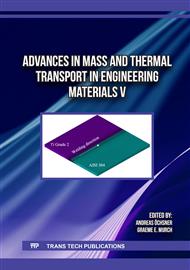[1]
W. Shen, A. Hu, S. Liu, H. Hu, Al-Mn alloys for electrical applications: a review, Journal of Alloys and Metallurgical Systems. 2 (2023) 100008.
DOI: 10.1016/j.jalmes.2023.100008
Google Scholar
[2]
J. Doerr, N. Ardey, G. Mendl, G. Fröhlich, R. Straßer, and T. Laudenbach, The new full electric drivetrain of the Audi e-tron, In: Liebl, J. (eds) Der Antrieb von morgen 2019. Proceedings. Springer Vieweg, Wiesbaden
DOI: 10.1007/978-3-658-26056-9_2
Google Scholar
[3]
H. Ishikawa, Y. Takashima, and Y. Okada, Squirrel-Cage motor Rotor and Squirrel-Cage Motor. U.S. Patent No. 9,935,533, 4 March 2018.
Google Scholar
[4]
Y. Li, A. Hu, Y. Fu, S. Liu, W. Shen, H. Hu, and X. Nie, Al alloys and casting processes for induction motor applications in battery-powered electric vehicles: a review, Metals. 12 (2022) 216-241.
DOI: 10.3390/met12020216
Google Scholar
[5]
Y. Li, Y. Fu, A. Hu, X. Nie, and H. Hu, Effect of Sr and Ni Addition on Microstructure, Tensile Behavior and Electrical Conductivity of Squeeze Cast Al-6Si-3Cu Al Alloy, Key Engineering Materials. 921 (2022) 3-14.
DOI: 10.4028/p-045ngi
Google Scholar
[6]
P. Sivanesh, K. Charlie, S.J. Robert, F. Ethan, and Paul, E. Aluminum alloys for die casting. U.S. Patent No. WO 2020/028730 A1, 6 February 2020.
Google Scholar
[7]
X.H. Chen, L. Lu, and K. Lu, Electrical resistivity of ultra-fine grained copper with nanoscale growth twins. J. Appl. Phys. 102 (2007) 083708.
DOI: 10.1063/1.2799087
Google Scholar
[8]
Aksöz, S.; Ocak, Y.; Mara¸slı, N.; Çadirli, E.; Kaya, H.A.S.A.N.; Böyük, U. Dependency of the thermal and electrical conductivity on the temperature and composition of Cu in the Al based Al–Cu alloys. Exp. Therm. Fluid Sci. 34 (2010) 1507–1516.
DOI: 10.1016/j.expthermflusci.2010.07.015
Google Scholar
[9]
Plevachuk, Y.; Sklyarchuk, V.; Yakymovych, A.; Eckert, S.; Willers, B.; Eigenfeld, K. Density, viscosity, and electrical conductivity of hypoeutectic Al-Cu liquid alloys. Metall. Mater. Trans. A. 39 (2008) 3040–3045.
DOI: 10.1007/s11661-008-9659-2
Google Scholar
[10]
Kaya, H.A.S.A.N. Dependence of electrical resistivity on temperature and composition of Al–Cu alloys. Mater. Res. Innov. 16 (2012) 224–229.
DOI: 10.1179/1433075x11y.0000000041
Google Scholar
[11]
M. Y. Murashkin, I., Sabirov, X., Sauvage, & R. Z. Valiev, Nanostructured Al and Cu alloys with superior strength and electrical conductivity, J Mater Sci. 51(1) (2016) 33-49.
DOI: 10.1007/s10853-015-9354-9
Google Scholar
[12]
S. Liu S, A. Hu, H. Hu, X. Nie, N.C. Kar, Potential Al-Fe cast alloys for motor applications in electric vehicles: An overview, Key Eng. Mater. 923 (2022) 3-19.
DOI: 10.4028/p-3027xi
Google Scholar


